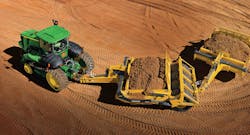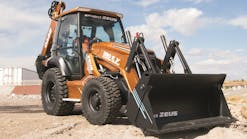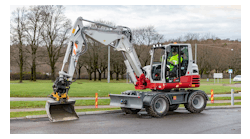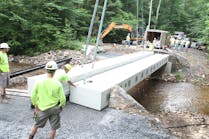As air-quality standards tighten and local officials clamp down on violators, some grading and excavating contractors are finding that dirt cheap can be painfully expensive-especially if that dirt has been carried off their construction sites and dumped on someone else.In Albuquerque, NM, for example, earthmoving contractors can be slapped with fines ranging from $200 to several thousand dollars for each day they allow dust to blow off a construction site. In addition, their work permit can even be suspended until the problem is fixed.It’s a similar, but more costly, story in Las Vegas, NV. There, the local air-pollution-control agency hears from about a thousand callers a year who phone to complain about dust from construction sites. The minimum fine for failure to control dust properly is $1,800. Typically, the first offense costs a contractor about $2,000. Add another $2,000 or so each time excess dust leaves the site after that. The total tab for a few contractors has run as high as $30,000.Soil tends to stay in place, naturally, by forming a crust or by absorbing moisture. Construction activities that disturb the soil, however, break up this crust and promote evaporation of moisture. That leaves soil more vulnerable to wind. So does clearing vegetation by removing plant roots, which help hold soil in place. If the soil is left unprotected from the wind, soil particles can become airborne and cause all kinds of problems.Sediment flying through the air can gum up the works and wheels of our mechanized world; leave a gritty covering of fine sediment on our cars, lawn chairs, and gardens; pile up on our streets; plug up swimming pools and storm-drainage inlets; soil our buildings, bridges, and clothes; and seep inside our homes. And that doesn’t include the health threats posed by dust. Microscopic soil particles can carry such noxious materials as heavy metals and bacteria, endanger motorists and pedestrians by reducing visibility on roads, and irritate our noses, throats, and lungs. Once inhaled, dust can aggravate asthma and heart problems, lead to illnesses such as bronchitis, and even cause premature deaths.The authority to crack down on dust from construction sites and other sources stems from the federal 1990 Clean Air Act. It requires states to monitor and control small, airborne particulate matter called PM10-particulate matter that is less than 10 microns in diameter. That’s tiny. A thousand particles of this size can fit inside the period at the end of a sentence. Dust-along with particles of tires and brake linings, smoke from wildfires and barbecues, hydrocarbons emitted by gas combustion engines-and other materials falls into that category.A 1997 national study found that construction activities contributed 13% of the total PM10 levels in the air. In the Las Vegas area, construction activities currently account for about 35% of all such particulate matter, reports Michael Naylor, director of the Clark County Health District’s Air Pollution Control Division.Blowing dust-the telltale sign of wind erosion-tends to be more of a problem at construction sites in the arid and semiarid parts of the western United States than in eastern areas. In fact, in many areas of the West, wind causes more soil erosion than does rainfall. Wind erosion, however, can occur anywhere disturbed soils are dry and unprotected and wind speeds exceed about 13 mph, reports hydrologist Jerry Fifield, CPESC, president of HydroDynamics Inc. in Parker, CO.“Unlike water, which flows downhill, wind can blow dirt and dust in any direction,” he adds. “That complicates the job of controlling it.”Dust Problems in the Southwest
Albuquerque offers an instructive look at how one major city deals aggressively with a serious dust problem. To begin with, the arid climate, where annual rainfall averages no more than about 9 in., leaves the soils dry and subject to blowing. The soils themselves add to the problem. The Rio Grande River divides the city into two major types of soils: the very fine-textured clays to the east that can be very stable when moist and the fluffy, fine-grained, sandy soils in the west. They are especially vulnerable to winds. And then there is the wind. Wind storms, with wind speeds greater than 55 and 60 mph, are common in May and June. Such conditions can bring construction activities, such as digging, pushing, lifting, and dropping, to a halt for half a day or longer.Larry Caudill, who supervises Albuquerque’s dust control program, explains what can happen when disturbed soil at construction sites in a housing subdivision are left unprotected from the wind. “The most common problem is sand drifting across streets and new landscapes, sometimes as deep as 12 to 15 inches. I’ve seen changes in grade elevation exceeding 5 feet due strictly to wind erosion. Drifting sand can also block drainage ways and bury irrigation systems. Even stabilized sites can erode as a result of abrasion from dust blowing in from unstabilized sites upwind.”To help prevent such problems, the city has developed a series of regulations to control dust-producing activities at construction sites. The rules were adopted in 1972 to improve scenic vistas and protect property, but they have since been revised to help protect health too, as required by the Clean Air Act.The rules prohibit discharge of airborne particulate matter that might cause injury, property damage, significantly reduced visibility, or a safety or health hazard. Anyone disturbing the soil surface on any site 0.75 ac. or larger must have a valid surface disturbance/demolition permit. Typically, that affects about 250 active construction sites at any one time in Albuquerque and surrounding Bernalillo County.Among the requirements to obtain the permit is a plan that indicates what measures will be taken-short-term, midterm and long-term-to prevent dust from leaving the site. If dust can’t be controlled, soil-disturbing activities must stop. Any work on a construction site that doesn’t create dust, however, may continue.“What man can cause, man can also prevent,” states Caudill. “The most challenging part of my work is educating project owners and contractors of their responsibility to control dust from construction sites. The city doesn’t subsidize the cost of cleaning up the dust. We think it should be the party causing the damage and not the public sector.”Part of the education involves seminars that Caudill and his staff conduct from time to time for earthmoving contractors.Winds can be a major problem in and around Las Vegas too. About 1,700 active construction sites, involving a total of about 20,000 ac., are operating under a dust control permit at any given time. Here, the permit is required on any site where soil disturbance covers 1.4 ac. or more. This past summer, the largest single project totaled about 2,500 ac. The Clark County Air Pollution Control Division requires all construction superintendents and supervisors to attend a three-and-a-half-hour class about the hows and whys of dust control rules. This training is required at least every two years. Anyone cited for violating the rules, however, has to take a refresher class immediately.Dust Control ChallengesFrom a strictly monetary standpoint, preventing dust problems is cheaper than trying to fix them later.Caudill tells of one case in Albuquerque in which the city fined a contractor for failure to prevent dust from leaving an 11-ac. construction site adjacent to a public road. It cost the contractor $40,000 to relandscape areas buried by the airborne sediment. “He could have saved all that money if he had just spent 400 or 500 dollars per acre to prevent the dust problem.”The steps needed to help keep dirt from blowing depend on the size of the soil particles being eroded. The largest soil particles, 0.04 in. (1,000 microns) or larger in diameter, are too heavy to become airborne. Instead, the wind pushes them across the ground surface in a process called creep. This is how sand dunes move and shift. Saltation, which occurs predominantly about 6-12 in. above the soil surface, affects particles about 0.003-0.04 in. (80-1,000 microns) in diameter. They are small enough to be picked up by the wind but large enough to fall back to the ground fairly quickly. As they hit the soil surface, they dislodge more particles. “Anytime you have sustained winds for a while, you can get a tremendous amount of saltation,” Fifield points out. “This can account for about 50 to 80 percent of the soil blown off a construction site.”Soil particles smaller in diameter than 0.003 in. (80 microns) are the ones that can take flight for hundreds or thousands of miles. These particles usually represent less than 10% of total soil loss, Fifield notes. They are the ones that blew from Oklahoma and darkened the skies in the eastern states during the Dust Bowl days of the 1930s.In most cases, controlling dust at a construction site involves three different areas, and each area poses unique challenges.Active Construction AreasThe active area is where the dirt is being moved. Controlling dust here requires daily action throughout the earthmoving activity.Limit the Amount of Disturbed Soil. Obviously, the less soil disturbed, the less that can blow away. This, however, often works against the economics of mobilizing equipment and conducting earthmoving operations.Keep the Soil Moist. At many construction sites in arid and semiarid areas, water is the tool of choice for keeping dust down when bulldozers, scrapers, and the like are working. In some cases, water has already been applied to compact the soil and meet engineering requirements. Caudill notes, however, that it may take several days to get some subsurface soils wet enough to prevent dust problems.“A soil might appear loose and gravelly at the surface,” he says, “but you could have a really tight clay layer one foot down that doesn’t accept moisture. If you dig into it with a self-loading scraper, you could be creating a dust problem.”Typically, a tanker truck with a spray bar or gun runs ahead of the earthmoving equipment. A damp surface isn’t wet enough as far as Caudill is concerned. In Albuquerque, he likes to see water penetrate 0.25-0.50 in. deep into the soil to form a crust.“I’ve seen some contractors who, because of prewetting a site adequately and the type of soils at the site, could keep working without soil blowing off-site, despite winds in excess of 50 miles per hour,” he recalls. “I’ve seen others, who were working very light, fluffy soils-which they didn’t prewet-violate our dust control ordinances in winds of only 8 to 10 miles per hour.”The frequency of wetting areas depends on soil types and traffic. Some soils hold moisture longer than others. In Las Vegas, the Air Pollution Control Division requires that active construction sites be watered as needed to prevent a dust problem.“If you’re digging a trench, thoroughly soak the area ahead of time,” says Naylor of the Air Pollution Control Division. “We want as little dust as possible leaving a site, no matter when the wind might come up. A water truck should be working in tandem with a bulldozer, watering the soil ahead of the blade. We like to see one water truck working for every three pieces of heavy earthmoving equipment. At the end of the workday, the water truck must treat all exposed areas to create a stabilizing crust on the soil.”Heed Weather Conditions and Forecasts. Caudill suggests keeping an ear on the weather forecast and an eye on the sky, and planning earthmoving work accordingly.“Spring is the windy period in Albuquerque,” he explains, “so it doesn’t make much sense to tear up a lot of ground at one time, only to be caught by the wind. If you see black storm clouds coming, start watering before the winds hit. If winds are expected in the afternoon, water in the morning and prepare to shut down in the afternoon, if necessary.”Install Snow Fencing. The vertical slats on a snow fence, and the openings between them, slow the wind during a blizzard and create air turbulence. This in turn causes snow to be deposited leeward of the fence. In the same manner, this type of fence can also cause soil particles to drop out, states Fifield. It’s an expensive approach, probably costing around $2-$4/lin. ft. just for the material, he admits, but it can work.Of course, for most effectiveness, a snow fence should be placed perpendicular to the wind. That can be a problem, though, since wind direction varies.According to the USDA’s Natural Resources Conservation Service, every foot of fence height will cause sediment to be deposited 8-10 ft. leeward of the fence. So with a 4-ft.-high fence, wind-blown soil particles will tend to pile up 30-40 ft. downwind of the fence.Fifield once saw this approach work where strong, sustained winds had torn up an orange plastic construction safety fence installed to help stop blowing soil in a Denver, CO, suburb. In this case, the snow fence was placed on the upwind face of chainlink fencing used to reinforce the snow fence.Silt fencing slows flowing water, causing sediment to drop out of suspension. But it’s not effective in causing airborne sediment to settle to the ground, Fifield says. “Wind just tears up a silt fence,” he notes.Inactive Construction Areas
This is where grading, digging, or other earthmoving work has disturbed the soil, but work has ceased temporarily. Here the idea is to direct the wind away from the surface of the ground or to protect the soil if the wind strikes it.Control Water Erosion. That’s right: water erosion. Under EPA’s National Pollutant Discharge Elimination System program, erosion control plans must be approved before soil-disturbing activities begin on most construction sites 1 ac. or larger in size. Some of the practices used to control water erosion can also help limit wind erosion.For example, in Fort Collins, CO, a disk or other implement is often run on contours of slopes to rip up the soil and leave ridges. These ridges slow stormwater runoff, allowing water to soak into the soil.“These ridges can also deflect wind and raise it 5 or 6 inches above the soil surface,” explains Bob Zakely, a environmental specialist on watershed with the Water Quality Division of the Fort Collins Utility. “On most projects, that will eliminate the majority of wind-blown soil particles.”Rough Up the Ground. At most construction sites, the ground is well torn up from the work involved in putting in streets and utilities and constructing buildings. By protruding up into the air, these structures and related equipment and materials stored on the ground disrupt the wind to help reduce erosion.Protect the Soil. Here again, some erosion control practices and materials reduce the impact of both water and wind. “The worst thing you can do in terms of controlling wind or water erosion is to leave exposed soil unprotected,” cautions Fifield. “That’s an erosion disaster waiting to happen.”Several options for preventing such an outcome may be available depending on local soil and weather conditions and budgets.Seed and Mulch as Soon as Possible. Vegetation is nature’s best erosion control material. Leaves and other aboveground parts of a plant protect the soil by absorbing the erosive force of raindrops and slowing the wind, while the roots hold the soil in place. Typically, annual grasses, such as rye grass, are seeded as a temporary erosion control practice. Broadleaf weeds can also help protect soil. They’re not as effective as grasses, however, because of lower stand density. Mulch, such as straw or wood fiber in the form of hydromulch, can protect the soil surface until newly seeded vegetation can take over.“Every major wind erosion problem I’ve seen at a construction site resulted from leaving a large area totally bare,” notes Fifield. “If you have a lot of exposed land, the first thing you should do is protect it with a temporary cover crop or other material. Then you can install other measures, like a silt fence.“Last year, one developer in the Denver area planted wheat immediately after clearing about 200 acres of land, even though he would be building there later. That greatly reduced the potential for wind and water erosion.”The required erosion control plan for most larger projects in Fort Collins calls for sites to be seeded and mulched within 30 days of initial land disturbance. In the interim, disking or ripping of the soils is required. Enforcement of this seeding and mulching requirement was stepped up several years ago. “Since then there’s been a tremendous improvement in the amount of fugitive dust knocked down during winter, when we have our heavy windstorms,” he says.Vegetation isn’t always a viable option, however. For example, in Albuquerque’s dry climate, it takes at least two growing seasons for a native seeding to have any significant impact on reducing erosion, reports Caudill. Mulching-spreading hay or straw over the seeded area and crimping it-stabilizes the disturbed soil until the seeds germinate and the grass cover produces long-term stabilization.Dust Palliatives. A variety of chemical products can be sprayed over dormant sites, including stockpiles of soil, to bind soil particles together and suppress dust emissions until construction activities resume. These materials protect the underlying soil from wind and water erosion; some stabilize the surface of the ground, others may penetrate as deep as about 3 in. to provide three-dimensional stability. These palliatives include polyvinyl acrylic (PVA) polymers, acrylic copolymers, polyacrylamides, lime-based cementitious materials, water-emulsified petroleum resins (but not motor oil, which can harm the environment), and bonded fiber matrices (mixtures of hydraulic mulch and gypsum or a vegetable starch). Their effectiveness and longevity can be affected by such factors as rate of application, soil pH, moisture levels in the air or soil, and amount of sunlight, plant growth, and traffic. They tend to be used more in the semiarid or arid areas of the western states than in the East, where higher rainfall keeps soils more moist and there is more vegetation to help slow the wind.The number of different products on the market and the performance claims made by them can be confusing. Application contractors, such as Soil Solutions based in Las Vegas, can help excavating contractors and project engineers sort through the many options. “One of the factors we consider in selecting a dust control product is how the site will be developed,” explains co-owner Troy Hildreth. “If it will eventually be planted with grasses, shrubs, and other vegetation, we don’t want to use a salt-based product, which will change the chemistry of the soil and hinder plant growth.“Most of the products on the market in our area work well,” he reports. “But they have to be applied correctly according to manufacturers’ instructions. If you try to cut corners by reducing the rate of application, for example, they won’t work.”How does a grading and excavation contractor evaluate the quality of a dust palliative or an applicator? Ask for references and recommendations from other excavation contractors or some independent verification of product or service claims, suggests Robert Vitale, president of Midwest Industrial Supply Inc., which produces and applies various dust control products. He points out that several programs have been established in the past few years to give buyers credible information about various technologies, such as dust control suppressants. One such service is Canada’s Environmental Technology Verification Program. (For more information, contact ETV Canada, PO Box 85059, 867 Lakeshore Rd., Burlington, ON L7R 1G0 Canada; ph: 905/336-4546; fx: 905/336-4519; Web: www.etvcanada.com.)“ETV verifies independent performance studies of the manufacturer’s product performance,” Vitale describes. “Companies whose product performance claims are verified receive a verification certificate, which assures customers that the product or technology performs as claimed. California and New Jersey both have Environmental Technology Verification Programs and have reciprocal agreements with Canada’s ETV program. Other states are in the process of developing similar product verification programs.”While product price is one piece of useful information for buyers of dust suppressants, it isn’t necessarily the most important, says Lou Snow, CPESC, vice president of Dust Pro Inc. in Phoenix, AZ, a dust palliative supplier and applicator. He suggests reading the product’s Material Safety and Data Sheet for any ingredients that might exceed pollutant standards for stormwater runoff.“Throughout the country you must have a National Pollutant Discharge Elimination System permit to disturb soil at a construction site,” he states. “That permit sets limits on the amount of pollutants allowed in stormwater runoff from these sites. Those values vary from one municipality to the next. The project owner is responsible to ensure that dust control products don’t violate this permit. If you apply a product that isn’t environmentally friendly and it gets into a storm drain, you might have a problem.”EPA does not endorse any specific dust suppressant and has not done any comprehensive testing to determine the impact of suppressants on water quality, reports Colleen McKaughan, associate director for the Air Division of EPA Region 9 (Arizona, California, Hawaii, and Nevada). In the meantime, she notes, research is being undertaken by EPA and several states to determine if, in fact, dust palliatives do pose a threat to water quality. Results are expected within the next year or two.“EPA still recommends using dust suppressants as one way to deal with dust problems,” McKaughan says. “It doesn’t appear that any environmental damage from dust control products has been identified. Liability from any damage to water quality caused by a dust suppressant depends on local laws and applicable permits.”Control Traffic. The wheels and tracks of construction and other vehicles can ruin the effectiveness of vegetation and other materials used to protect disturbed soil, so it pays to keep traffic off such areas.“Traffic across it will soon chew it up,” says Caudill. “Then the wind will finish the job, leaving you with an unstable site.”Traffic AreasControl Road Dust. Some of the same dust palliatives used to control dust on inactive construction areas-such as PVA polymers, acrylic copolymers, and water-emulsified petroleum resins-can also be used to hold down dust on haul roads, parking areas, and other traffic ways. The rate of application and frequency of treatment, however, may be increased. These products bind soil particles together and create a durable surface that can withstand the weight of vehicles, often for several months before retreatment is required. The frequency and rate of application of each material depend on a variety of site conditions. They include the type of soil and vehicles; the volume, speed, and frequency of traffic and the stability of the road surface; the amount of dirt spilled or tracked onto the road by vehicles from untreated areas; and the weather. Other dust suppressants are suitable only in traffic applications. They include magnesium chloride and calcium chloride. Unlike products that bind soil particles, these salts hold down the dust by pulling moisture out of the air. As long as there’s moisture on the road or in the air, they are effective. The binding abilities of lignin sulfonate can also control road dust. Nature uses this material to glue together the cellulose in trees.The amount of dust produced by cars, trucks, and other wheeled vehicles is surprising. Colin Kimball is a marketing and product manager with Pennzoil Products Company in Houston, TX, maker of a dust control palliative. Using a device mounted 1 ft. behind a rear tire of a 3/4-ton pickup truck and 1 ft. above the ground, he collected soil particles kicked up by that tire as the vehicle traveled at 20 mph on an untreated dirt haul road at a mine. At the end of just 1 mi. the total weight of the dust collected was 50 lb.Kimball points out that dust abatement isn’t the only reason to use a dust suppressant. “The dust you see from an unpaved road is made up of the fines that help bind coarse aggregate particles together to stabilize the road surface,” he explains. “By controlling dust, you’re also helping to preserve the binder that holds the road together.”In some areas, water is a popular material for controlling dust on unpaved roads. But Kimball, like others who sell dust palliatives, adds that water is a more costly, less effective solution to this problem.“If you consider the costs of water and labor and frequency of application, water can be much more expensive in the long run,” he says. “The computer-controlled application equipment used with dust suppressants ensures very precise application rates for the most efficient use of the products. Also, water washes away fines in the road. So you need to include aggregate-replacement costs in your total water cost.”







